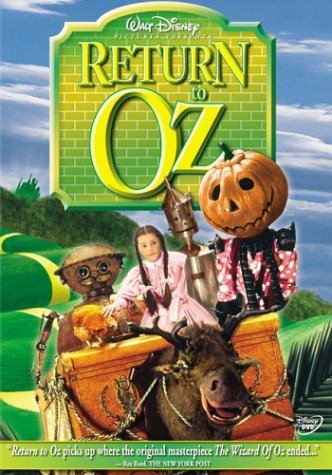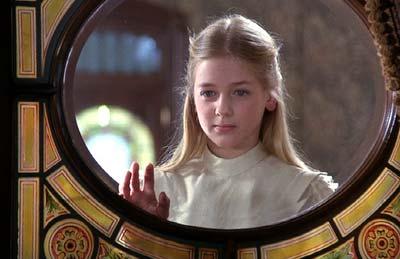Directed by Walter Murch
Written by Walter Murch and Gil Dennis
Starring Fairuza Balk, Nicol Williamson, Jean Marsh, Piper Laurie
The concept of a “Disney movie” will always be accompanied by a unique set of preconceived notions, and yet we can’t ever totally agree on what it means for a film to have “Disney movie” qualities. The presumption is that a “Disney movie” is not only family-friendly but potentially neutered, enforcing juvenile ideas that can frame a child’s mind throughout their entire adolescence. But sometimes, “Disney movies” rely on intense, nightmarish imagery that dwarfs any happy ending, any predictable moralistic message. So films like Bambi are remembered now less for an evocative depiction of nature, and more because the title character’s mother is felled by a bullet halfway through. And yet, even these championed favorites do not wallow in the darkness, or let that tone pervade the entire atmosphere. Bambi has a moment of cataclysmic horror, one of the most iconic scenes in film history, but the film as a whole is wall-to-wall naturalistic beauty. There is enough hope to pierce through the gloom.
There is very little hope to pierce through the gloom of Return to Oz, a film whose very existence is astonishing. I may disagree with my co-hosts here—contain your shock—but no matter how enjoyable this movie is, it decidedly feels antithetical to the tenets of the Walt Disney company. The matter-of-fact grimness in Return to Oz is refreshing, while also feeling like a slap to the face of any child or adult hoping for a happy-go-lucky sequel where Dorothy Gale returns to the land of Oz. It is exceptionally difficult for storytellers to maintain an appropriate balance of realism and fantasy, but first-time (and last-time) director Walter Murch, well-known as one of the preeminent editors in Hollywood, captured it quite well. I may have appreciated the realism than the fantasy, partly because the effects are either embarrassingly dated or firmly planted in the past. Even in the most outlandish scenes, this story is rooted in the real world, to a disturbing extent.
Twenty minutes into Return to Oz, Dorothy Gale is about to be given a 19th-century version of electroshock therapy, but that’s not as chilling as the fact that this potential threat isn’t totally illogical. In the world that L. Frank Baum created, a little girl travels to a magical land after a tornado lifts up her house and squashes a mean old witch. All of this is laid out as being as logical as opening up your umbrella when it begins to rain outside, so why shouldn’t the real-world reaction to what Dorothy says unfold similarly? Of course, the counterargument to this question wouldn’t so much be a disagreement as much as a wail: why would a Disney movie want to show this? Disney doesn’t like to traffic in the harsh realities of life anymore–it’s easy to think that Bambi wouldn’t have been made or released in the current landscape or even back in the 1980s. A film like Return to Oz seems tailor-made for a cult audience; of course it wasn’t going to be a massive hit, and of course the people who love the film do so feverishly, obsessively. What could the Disney executives who greenlit the film–not Michael Eisner, who was in charge when the movie opened in 1985–have been thinking? Sure, a follow-up to one of the most beloved family films of all time, and one where they didn’t even have to pay for the rights to Baum’s books, makes sense. But…this? Really?
The most distressing aspect of Return to Oz, at least for an adult, is that Fairuza Balk is a child. She plays a character who is in constant mortal danger–well, relatively speaking–and unlike Judy Garland, she looks the age of her character. The Dorothy from the 1939 film is, or appears to be, self-reliant. Oh, sure, she might run into some trouble here and there, and she’ll have to dump some water on that mean old witch, but, y’know…she’s a teenager. She’s more of a grown-up than a 10-year old would be. And unlike other child actors of the time, Balk isn’t enormously precocious or wise beyond her years. This Dorothy may, at one point, take on the mantle of maternity, but she’s a kid and she knows it. When the nasty old doctor plans to experiment on her with a crude form of electroshock therapy, it’s a hell of a moment. Here is a movie that is not playing around, because it’s willing to go pretty damn far with the possibility of zapping its sweet protagonist’s poor little brain.
What makes me think this film is only good, not great–and hey, knowing me, I guess that’s a moral victory of some kind–is that Return to Oz frequently tiptoes near greatness, in a cultish way, before it backs off. This movie isn’t able to commit. I guess I shouldn’t be advocating, or even hoping, for Dorothy to get shocked in that early scene–and depending on how you read the film, she does, according to my co-host Gabe Bucsko. I wanted Murch and company to go through with their convictions, as twisted as those may be. In some ways, I imagine the Disney brand as a disadvantage. Murch can show us some creepy images, but not too creepy. He can throw in some darkness here and there, but not too much. (The whole film is baffling and bugnuts crazy, of course, but once Dorothy is interacting with her talking chicken, Jack Pumpkinhead, and a talking moose, the darkness has been leavened thoroughly.) I give credit to Murch for making this film, and I give credit to Disney for releasing it. I just wish it went further, just a wee bit.
I don’t know why I ended up liking such a strange little film, especially when a good deal of the people involved were somehow related to the still-popular Disney theme-park attraction Captain EO, directed by Francis Ford Coppola and produced by George Lucas. (These two men were instrumental in swaying the Disney executives to let Murch finish out this film, after he’d been kicked off the project midway through shooting.) Both have a plethora of special effects, both are dated by now, and both are quaint in how they expect to entertain audiences. Something about Captain EO rankles me more–whatever fame and adoration the late Michael Jackson still gets more than three years after his untimely passing has allowed it to stay open, after having been closed for nearly 15 years. Maybe it’s that simple: Captain EO is getting a level of passion that Return to Oz deserves. If you’re a fan of both projects, you may disagree or you may admit that the latter deserves at least a smidgen of what the former gets. So many people clearly saw this film in some form back in the late 1980s and early 1990s. If they had the Disney Channel, back when they focused less on new content, more on whatever was in their archives, these children probably have a memory of this film, just as they might of the supposed adventure of Captain EO and his intrepid crew.
Return to Oz is something of a charming mess. Even though its nightmarish quality, the way it captures an unnerving level of dream logic without hitting us over the head with it, is consistent, the film isn’t perfect. Some of the characters are either obnoxious or superfluous. And it’s hard for a person who hasn’t read the Baum novels–of which there are a surprising amount–to not compare this or relate it to the 1939 film everyone knows so well. If that Dorothy acted one way, why does this one act so totally different? Why does one know more about Oz than the other? The script assumes a higher level of familiarity with source material than is appropriate; it’s a rare case of a film presuming more about the audience’s intelligence than is appropriate. I may have embraced this a bit more because of its reputation. Return to Oz is likable because it’s quaint, because it’s the underdog. Would that Disney eventually gives it a chance, even if it’s far away from what a “Disney movie” is meant to be.




